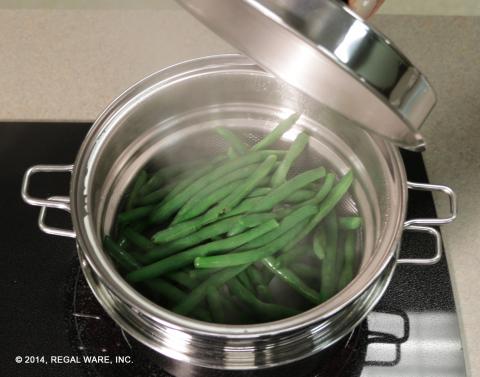
Blanching is a term that usually refers to the very brief cooking of a fresh vegetable prior to freezing. Blanching typically involves vegetables rather than other types of food (like fruit or meat) because vegetables are particularly susceptible to enzyme-triggered changes that can result in lost flavor, lost color, and lost texture during freezing.
Although Saladmaster does not recommend steam cooked vegetables, this is a necessary process when freezing fresh vegetables for later use. This prevents unwanted changes in flavor, color and texture, and thoroughly cleanses the vegetable surface to destroy unwanted microorganisms.
It is worth remembering that the freezing of a food does not destroy bacteria, yeast, or molds that might be present on the food. Freezing will inactivate these microorganisms, but when food is eventually thawed, these microorganisms may become active once again. Given these factors, the blanching of fresh vegetables prior to freezing makes sense to lower potential risk of activity on the part of unwanted microorganisms.
Use caution when blanching, as over-blanching, vegetables will end up destroying a wide variety of nutrients as well as flavor, color and texture. If you under-blanch you may end up increasing the activity of enzymes you were seeking to de-activate.
Saladmaster recommends vapor blanching vegetables to minimize nutrient loss. The 6 Qt. (5.67 L) Culinary Basket is ideal when used with the 10 Qt. (9.5 L) Roaster for vapor cooking fresh vegetables for the freezer. This method avoids immersion of the vegetables directly in the boiling water and instead surrounds the vegetables only with vapor.
Vapor blanching is followed by quick and brief immersion of the vegetables into cold water. As a guideline for cooling in cold water, simply keep the vegetables immersed in the cold water for the same amount of time as was used for vapor cooking. For example, if you vapor cook for 3 minutes, immerse in cold water for 3 minutes as well.
The size and density of foods determine how long to blanch different vegetables before freezing. Below is a list of vegetables that freeze well and the recommended vapor cooking time for each.
After blanching, there are two more essential steps before you put the food into the freezer. The first is to immediately plunge the blanched vegetables into ice water or run cold water over them. You want to cool the food down as quickly as possible so that it doesn't continue cooking from the residual heat.
After the food has been quickly cooled, drain well. With leafy greens, squeeze out as much liquid as possible. Excess liquid will result in poor quality frozen food.
Recommended Blanching:
|
Vegetables |
Recommended Vapor Cooking Time (in minutes) |
|
Artichoke (hearts) |
6 |
|
Asparagus (whole) |
2 – 4 (depending on thickness of stalks |
|
Beans (green or wax) |
3 |
|
Broccoli (1 inch/2.54 cm pieces) |
2 |
|
Brussels Sprouts |
3 – 5 (depending on size) |
|
Cauliflower |
3 |
|
Corn (on cob) |
6 |
|
Kohlrabi (1 inch/2.54 cm pieces) |
1 |
|
Leafy Greens |
1 – 2 minutes (2 minutes for collards and cabbage) |
|
Okra |
2 – 3 (depending on size) |
|
Peas (pod) |
2 – 3 (depending on size) |
|
Peas (shelled) |
1.5 |
|
Squash (Chayote) |
2 |
|
Squash (Summer) |
3 |
Remember that even perfectly blanched and frozen vegetables do lose some of their nutritional content over time, so it is important to label your frozen foods with the date they were frozen and make note of how long foods can be frozen.
